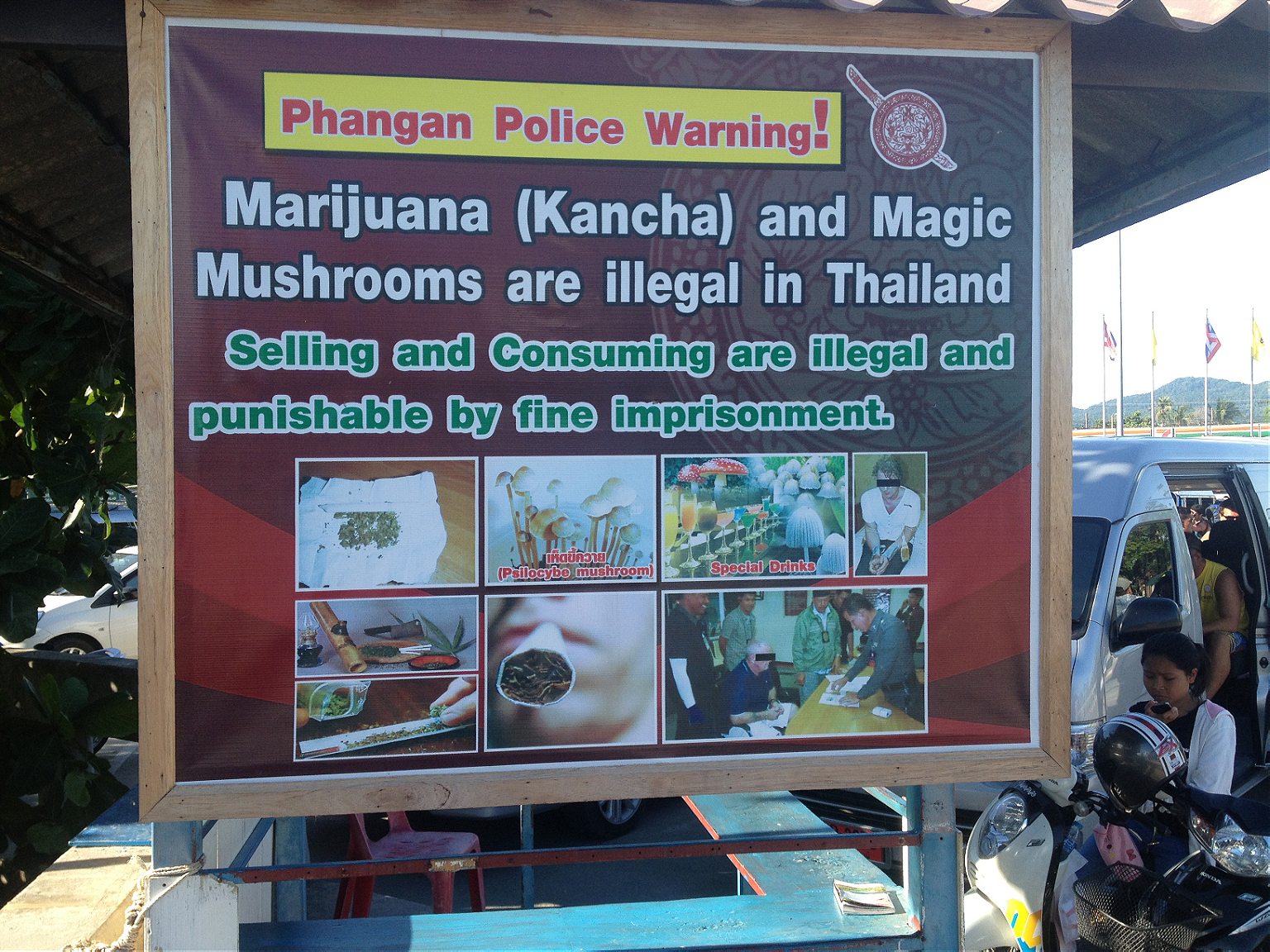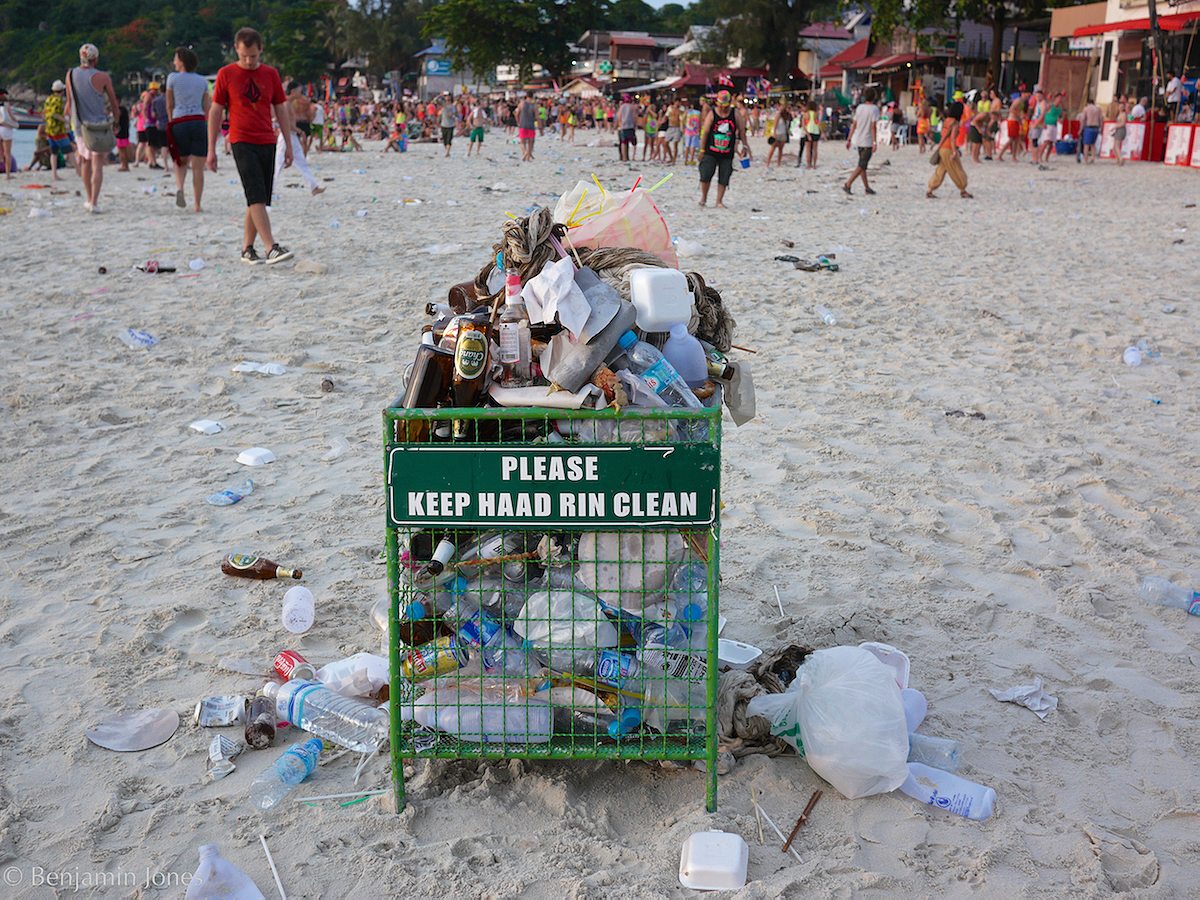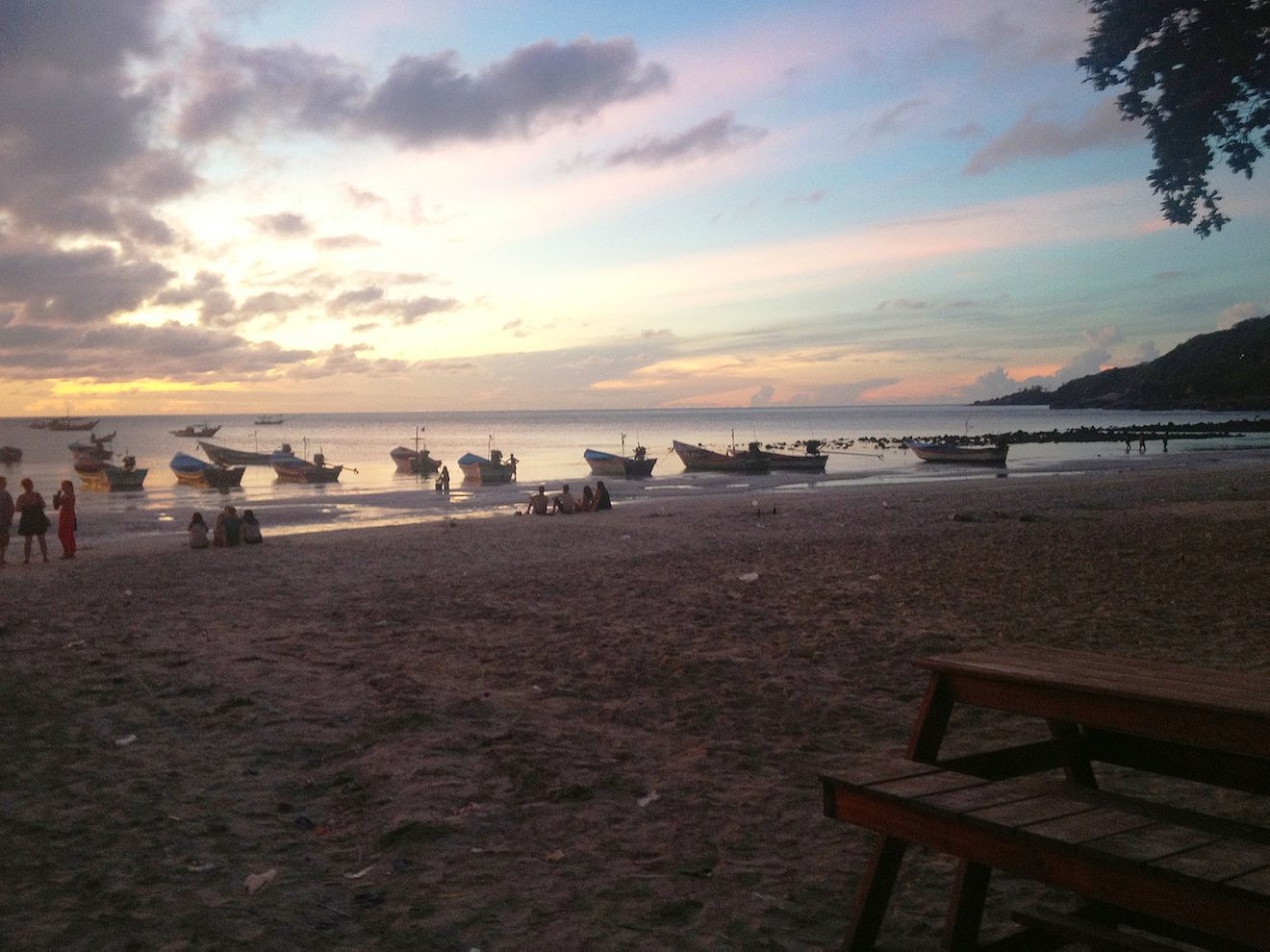Thailand’s Full Moon Party is debauched, depraved, and increasingly deadly. If only it were fun.
KOH PHANGAN, Thailand—
“HELLOOO, FULL MOON PARTY!” the touts holler.
Welcome to Koh Phangan… I guess. The host of tuk-tuk drivers and solicitors who await the tourist ferry-load arriving every hour make no mention of the actual island. It’s all about the party. Or rather, parties. Every night.
The next greeting is a giant billboard that warns, “MARIJUANA AND MAGIC MUSHROOMS ARE ILLEGAL IN THAILAND.” Bottom-right is a photograph intended to terrify anyone fresh off the boat: a white-haired foreigner, eyes blacked out, seated before a bunch of cops. Oddly, one policeman flashes a sinister grin.
Minutes later, our minivan filled with backpackers bounces down the 10-kilometer road toward Haad Rin, where the party happens. Most passengers are carrying coffin-sized luggage and look weary. Where’s a copy of the Daily Mail with the latest about some dead Brit? These kids surely need to be warned.

Koh Phangan’s Full Moon Party long ago lost its original innocence, devolving into a mess of drunken foreigners cramming onto a once-beautiful beach to celebrate nothing more than the party itself. But in recent years, things have gotten much worse. There have been rapes, fatal accidents, suicides, and gang-related murders. “In the nine months I lived there, one guy I admired hung himself, while another died drunk-driving his motorbike,” a former expat told me. Meanwhile, the local environment has been decimated. In fact, one’s first taste of the island pleasures that await can be found in the water itself, which glistens with oil and plastic.
Yet most visitors are blasé about it. “If you’re a girl walking down the beach, you get this all the time,” a British voice in the minivan drawls to her Danish companion, making a firm, pinching motion. “My friend gets drunk and throws up… then she’s fine again,” another brays cheerfully.
It’s nearly 3 o’clock in the afternoon, hours before action time, where I might find, as a disgusted Mail reported, “naked couples bobbing up and down in the water,” a “sordid scene… lit by a beautiful, white full moon,” “a sign saying ‘F*** me,’ ” and “[h]ard drugs.”
This, supposedly, is the best party in Asia.
ON AN ISLAND WHERE NOTHING MUCH HAPPENED FOR HUNDREDS OF YEARS, THE CULTURE SOON CELEBRATED ANY EXCUSE FOR A BACCHANAL
It wasn’t always like this. The origins of the Full Moon Party on Koh Phangan, which is about 90 percent dense jungle with some gorgeous beaches, are unclear. “The Full-Moon Party started in 1987 or 1988, nobody really knows,” the island’s official guidebook unhelpfully notes, and almost everyone on Koh Phangan has an equally vague explanation for why 30,000 people converge here every month.
The myth is that a farewell party for a dozen tourists somehow mutated into a phenomenon that’s now the island’s virtual raison d’être. The facts are less tidy, but more interesting. They reach back to the end of the Cold War, where on a remote island, flower-power idealists with Indian monikers muttered about Shiva over some bongos. The waves then were said to sparkle with phosphorescence under a blue moonlight. (Thirty years later, phosphorescence sells for a buck a bottle and no one cares about Vishnu.)
Electricity hadn’t arrived when the Berlin Wall fell in 1989. Instead, on idyllic Koh Samui, just 13 kilometers from Koh Phangan, the waxing moon brought respite from the ferocious packs of feral dogs and knife-toting muggers who otherwise roamed the darkness. According to Colin Hinshelwood, a Scot who attended the original gatherings, the arrival of power changed everything. For Samui’s foreign collective, electricity was more colonialist expansionism. They looked across the Thai Gulf to a dark, unknown bay where people could continue living unfettered by capitalism: Haad Rin.
Back then, there was “[n]ot much alcohol at all; certainly no buckets,” Hinshelwood writes. Instead, hed kee kwai—buffalo-dung mushrooms—were chewed around the bonfire and nights ended with naked dancing and free love. Soon, Swedish organizers were selling acid to the new arrivals and it was just a few more months before “a gang of Phangan locals chased them off the beach with machetes, after stealing their drugs, of course.”
Later came Ecstasy and electro, Lonely Planet, and what friends back in England called gap-year “wow-yeahs”—Trustafarian types who couldn’t stop muttering about “the experience.” Around Haad Rin, though, local fishermen were experiencing getting strong-armed off their land by mafia-backed mainlanders with a nose for exploitation. On an island where nothing much happened for hundreds of years, the culture soon absorbed nearly everything and everyone, celebrating any excuse for a bacchanal—Half Moon Party, Jungle Party, Midnight Party, Waterfall Party, Boat Party, Solstice Party. The economy, meanwhile has become hopelessly corrupt, urging visitors to join the celebration immediately as they dock.

The Thai authorities make periodic attempts to stamp out more unsavory stuff across the country. Recently, in the coastal resort of Pattaya, two hours from Bangkok, the grimmest sois—home to the most “recondite” predilections—have been demolished and the town even touts itself as a family resort, although the sex trade still figures prominently. Moves are also afoot to “make [Koh Phangan] a drugs-free island,” as the Bangkok Post declared—in 2009.
Of course, purists say, it’s all changed now. Psytrance enthusiasts recall the good times before it went “commercial.” And listening to a dub-trip garage remix (or something) by One Direction for the third time, I wonder what exactly I’m doing here. The decision to visit the Full Moon Party with my girlfriend was last-minute: We saw a sign in a travel agency, realized it was a couple of days away, and thought: “Why not?” The only accommodation still available was a grotty, $25-a-night “bungalow” that would suffice as a base of operations. The six-hour catamaran journey from the mainland was a cattle feast.
I spent the previous night researching field reports. Maybe my search terms were gaming the results (“Full Moon Party” … “vomit”), but they made for grim reading: “I… remember losing my sandals and walking on a lot of glass,” read one. “I even saw a guy attempt to rape a girl on the beach… The girl was passed out… all I remember next was me and R looking for N and C, finding N with his shirt off being loud and yelling at strangers… blood was pumping out of [his nose] like a faucet… We hid in the jungle for what must’ve been at least an hour, R’s hand was covered in blood.” This woeful account concludes with the author nursing a dying dog.
Others expressed finger-wagging concern about the unbridled hedonism: “Someone had jumped from the second story of a building the previous night and gotten impaled by a metal rod,” one blogger wrote. “There’s more to life than fist pumping, snorting your brains out, and being an empty carcass the next day or couple of days.”
IT’S NOT UNCOMMON TO SEE SOMEONE URGENTLY MAKING THEIR WAY BETWEEN BARS ON A PAIR OF CRUTCHES
There are basically three types of business in Haad Rin: bars, pharmacies, and hospitals. Emergency medical attention can be found on every corner, often sporting grandiose names (the Stamford Clinic) or claims (“Because we care.”) After a few hours, you realize why: Almost everyone wears a bandage, or walks with a hobble. (In Koh Phangan, the island’s hilly, ramshackle roads and hairpin corners have bested so many bikes, locals supposedly call their brutal scars “Koh Phangan Tattoos.”) It’s not uncommon to see someone urgently making their way between bars on a pair of crutches.
Combine alcohol, youth, the ocean, and dangerous roads, and you can understand why death has became so much a part of the Full Moon celebration. (Foreigner fatalities in Thailand are not just reserved for Koh Phangan. A newspaper in Phuket, another seedy tourist spot, described the 35 official expat deaths over one six-month period as “surprisingly low.”)
“Death in Paradise” makes for a righteous headline, and in recent years there have been plenty of sensational stories to choose from. In 2009, German tourist Astrid Al-Assad Schachmer, 45, was raped, murdered, and dumped in the shallows after one party. That same year, Becki Beckmann, another German in his mid-40s, faced off against a pair of armed men attempting a home invasion, and a French tourist was found hanging in a police cell under disputed circumstances. Others die en masse, like the 18 who died in 2005 after their taxi-boat sank, or the 10 killed when a tour bus crashed two years ago.
Lately, the casualties all seem to be British, like the 19-year-old who drowned off Haad Rin while drunk, or 22-year-old Stephen Ashton, who caught a stray bullet in the crossfire between rival Thai youths at Zoom Bar. (The party allegedly continued.) A year later, Kevin Liddle lost an encounter with a plate-glass window. Within a couple of months of Liddle’s death, 29-year-old Alex Wyithe fell victim to a full-moon riptide. “He had gone to Thailand on a two-week holiday to have a hair transplant,” the Daily Mail reported.
One Thai woman who’d agreed to an interview pulled out as soon as Ashton’s death was mentioned. (I’d only intended to ask whether the incident had improved safety.) The island’s business community is understandably wary, saying the media has focused too heavily on these deaths. On this topic, local police were particularly terse with me: “No comment. Where are you staying?”
Thai men are hard at work throwing up makeshift sound systems along the 1-kilometer beach as we arrive at 4 p.m.; otherwise there is little indication of the crowd to come.
By 10 p.m. the beach is thrumming, but the party’s only getting started. We take a long trawl. Each stage attracts a slightly different crowd. The wall of “bucket bars”—wooden stands called “Dave,” “Batman,” or “Michael,” selling colorful pails containing a half-bottle of spirits, juice, and Krating Daeng, a truckers’ favorite that makes Red Bull look soporific—is monolithic.

For all the dire warnings, alcohol, not drugs, is the main reason people fall off stages, step on glass, tumble down cliffs, or otherwise do violence to themselves on Phangan. In response to the Ashton shooting, representatives of the Royal Thai Police have cooperated with British consular officials to offer a uniformed presence, via a tented command center in the middle of the beach. The boys in blue exude cool reassurance rather than buzzkill. The cops are smiley, happy to pose for pictures even if your pockets are laden with weed. Just another part of the tourist industry.
On top of the police presence, there are persistent rumors of entrapment operations run by narcs to trick dopey drunks. As I stroll the beach, I’m repeatedly offered to buy “something.”
Meanwhile, the gasoline-fueled fire shows are kicking off, featuring dancers, burning ropes, and baton-twirling displays of acrobatic skill. Despite the proficiency of the teen performers, the Full Moon mob rewards mistakes over merit, chuckling at every dropped ball and roaring with approval after one giant, flaming cotton bud nearly sets a tree alight. (There’s also a high incident rate at the bottom of the makeshift flaming luge, which ejects passengers into the paths of startled passersby.)
As the night wears on—and boy, does it wear—partygoers can find help at the many local pharmacies, which offer a full panel of prescription drugs, no questions asked. Codeine, Xanax, Valium, Ritalin. On the beach, however, open use of drugs like marijuana is not tolerated.
The party continues until dawn—thousands of people, drinking, dancing, and passing out. Haad Rin doesn’t have phosphorescence—not these days, at least—but whoever makes the town’s supply of glow paint is doing well; everyone is wearing the stuff.
Dawn is the ideal selfie time, and revelers line up to take their shots. It’s also the time to take stock of the rejected paraphernalia: thousands of plastic straws, bags, blinking Minnie Mouse ears, bracelets, and empty cups. This is the reality of the Full Moon Party.
“Unfortunately there is no way to measure the impact of a single Full Moon Party on the ecosystem,” says Benjamin Jones, whose recent documentary Trouble in Paradise records the damage. “Hundreds of bottles, cigarette butts, and plastic straws end up in the ocean [every time].”
A small group of dogged scrap-pickers arrives, sent by the Haad Rin Business Association. Formed in 2008, two years later the guild began charging entrance—an administration fee that supposedly includes a cleaning patrol that shows up sometime around 9 or 10 a.m. “Unfortunately by that time, a lot of garbage has already drifted out into the ocean,” Jones says.

Previously, the ocean was actually part of the cleanup plan: Up until 2005, “people [were] actually sweeping the trash into it.” One volunteer described the washing-up of a dead dolphin, its stomach stuffed with trash, as a call to arms of sorts. It was only in 2011 that bins were even installed on the beach (“ludicrous,” says Jones), and soon even these receptacles overflow with debris.
The next day, Haad Rin is silent. Its streets are deserted, the masses from the night before sleeping off hangovers or battling harsh comedowns. The nearest public “bathroom,” a darkened entrance where drunks were gouged 10 baht to enter the night before, is now an unmarked cave.
I sit in a British pub eating bangers and mash (because this is Thailand) and reflect on what I’ve seen. With the deaths, environmental damage, fighting, and general debauchery, you would think that a party that draws tens of thousands of people, month after month, would at least be … fun. It’s not. Not even remotely. And for all Koh Phangan’s “vices,” I was never shocked or appalled. I was disappointed and bored, and for a party that calls itself the greatest in Asia, that’s surely the worst sin of all.
